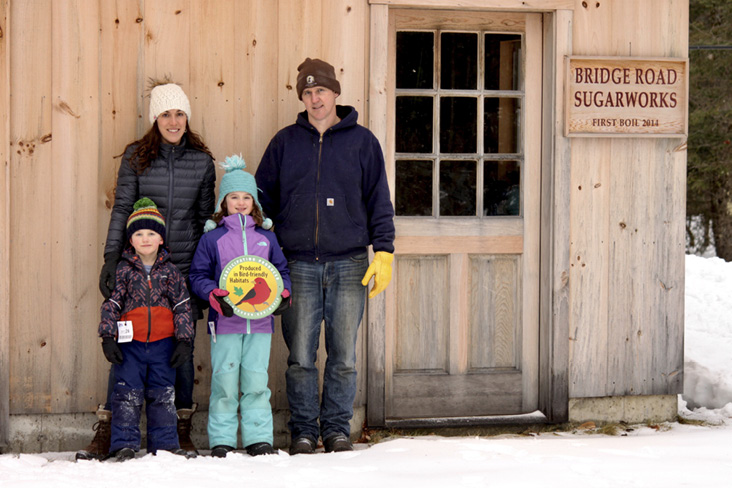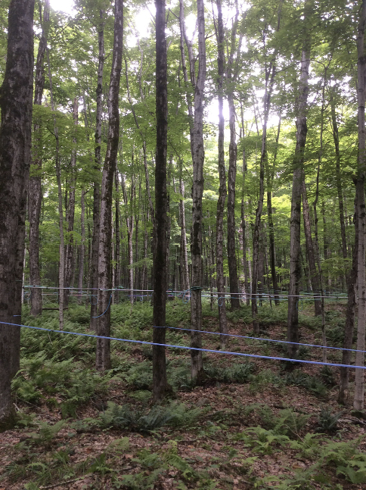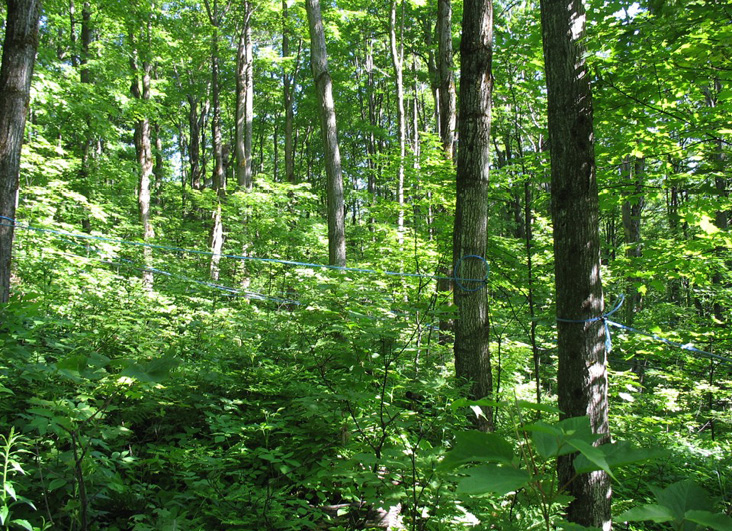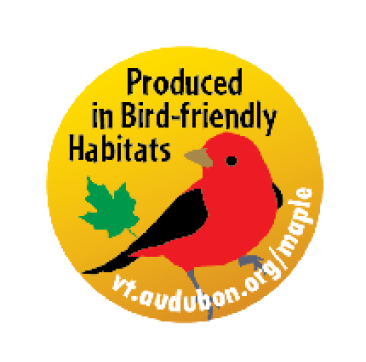Jeff Ritterson and Steve Hagenbuch

The owners and operators of Bridge Road Sugarworks pose with a bird-friendly maple syrup sign. Photo credit: Bridge Road Sugarworks.
October. The cool, crisp air is a welcome respite from the summer’s heat. We excitedly don our finest flannels and embrace this wonderful time of year in New England. Friends and families gather for the festivities of fall or one of many upcoming holidays. Amid the hustle and bustle, perhaps a lazy Saturday morning is in order, in a warm kitchen with a generous stack of pancakes. And of course, no pancake experience is complete without the requisite drizzle or, for a greater indulgence, pool, of pure maple syrup. Sweet maple flavor with notes of vanilla, caramel, and molasses, sticky on your lips and birdsong in your ears.
Wait, what!?! Birdsong? While birds may not be the first thing that springs to mind when considering the merits of maple syrup, the connection can be found in sugarbushes. Defined loosely as a group of maple trees used for syrup production, a sugarbush inherently provides some level of suitable forest bird habitat. After all, an intact forest is preferable over, say, a highly manicured lawn or parking lot. However, nuances in how a sugarbush is managed can have significant implications for the bird life that it supports and the conservation of forest bird species. A 2019 study reported that we have lost nearly three billion birds since 1970, a reduction of 29 percent (Rosenberg et al. 2019). A large portion of those losses were in populations of eastern forest birds, and New England is an especially important breeding area for many of those species (Goetz et al. 2014).

A sugarbush consisting of only canopy trees offers lower quality bird habitat. Photo credit: Audubon Vermont.
A well-established ecological principle is that habitats of higher complexity generally support greater biodiversity (McCoy and Bell 1991). By complexity, we mean the physical structure and arrangement of an environment. High complexity enhances biodiversity by providing a wide range of niches that allow superficially similar species to coexist. It also allows would-be prey to persist in the presence of predators by, for example, having places to escape (Kovalenko et al. 2012). Complexity’s contribution to biodiversity has been demonstrated in many ecosystem types and natural communities, including the woodlands of New England (DeGraaf et al.1998).
A complex forest habitat has layers of vegetation. The shrubs and saplings of the understory, or the area up to five feet in height, are the preferred nesting habitat for species such as the Black-throated Blue Warbler (Setophaga caerulescens). Above that, the trees in the midstory, between five and 30 feet in height, are where a species like the Wood Thrush (Hylocichla mustelina) will place its nest. These layers exist under a tall canopy of trees greater than 30 feet in height, where species such as the Scarlet Tanager (Piranga olivacea) will nest and forage for insects.
Additional features of a complex forest include cavity trees for nesters such as the Great Crested Flycatcher (Myiarchus crinitus), and gaps in the canopy where an Eastern Wood-Pewee (Contopus virens), for example, may sally out to catch insects on the wing. Canopy gaps also allow sunlight to reach the forest floor and promote growth in the understory and midstory. Also worth mentioning are dead standing trees and logs on the ground—often referred to as snags and coarse woody material, respectively—that are decomposing, providing insects for birds to eat, and generally adding to the structural complexity of a forest.
Another ecological principle that contributes to high biodiversity, and indeed can in turn add to structural complexity, is the species composition of a habitat, with a higher diversity of foundation species generally supporting greater overall biodiversity (Cardinale et al. 2011). In this case, we are talking about trees. As an example, some forest birds are strongly associated with softwood trees, such as the Black-throated Green Warbler (Setophaga virens) and the Blue-headed Vireo (Vireo solitarius). Thus the presence of softwood trees like the eastern hemlock (Tsuga canadensis) can add to the biodiversity of forest birds. What is more, shade-tolerant hemlocks tend to retain their lower limbs, adding complexity to the layers of vegetation below the forest canopy.

A sugarbush with a well-developed understory and midstory provides excellent bird habitat. Photo credit: Audubon Vermont.
Sugarbushes display a wide range of habitat complexity and tree species composition, from a meticulously tended monoculture of sugar maples to a more natural forest that happens to have a relatively high density of maple trees, and there is evidence that the basic ecological principles described above hold true. Hagenbuch (2009) found that both the number of individual birds and the number of bird species present decreased as maple trees became more prevalent in sugarbushes, suggesting that a monoculture of maples provides poorer habitat than a mix of trees. Conditions such as the number of maple trees and amount of vegetation in the understory can be adjusted with sustainable forestry and habitat management practices to make the resulting maple syrup more bird friendly.
As consumers, we can choose products that follow certain standards of production, and that includes the production of maple syrup. So, how do you know which maple syrup comes from bird-friendly sugarbushes? Look for the logo (Figure 1). Its stylized Scarlet Tanager tells you all you need to know, but for those who are curious, here are a few details on the production standards of bird-friendly maple syrup.
Part of what constitutes high-quality habitat for many forest birds is a large area of forest, so a sugarbush must first be part of a contiguous block of forest 100 acres or larger. The sugarbush itself can be smaller than 100 acres, but it must be part of a larger forest, which might also span property ownerships. Next, structural complexity and tree species diversity are considered. For example, management targets include having vegetation covering 25 percent or more of the space in the understory and midstory of the sugarbush, as averaged across all acres. Also, maple should account for no more than 75 percent of the sugarbush (as measured in basal area) to avoid a monoculture or near monoculture. Where present, the maple producer is asked to develop a plan for managing non-native plant species, which are detrimental to bird habitat and forest health. Finally, targets include an average per acre of two snags larger than 10 inches in diameter, and four downed logs larger than 10 inches in diameter and greater than three feet long. The authors can provide more detail on program requirements and production standards on request.

This label, with a stylized Scarlet Tanager, can be found on jugs of maple syrup that are recognized as bird friendly.
Management targets must be included in a forest management plan, which is typically written by a licensed consulting forester, and which details approaches to either maintain or achieve the desired forest habitat conditions within the sugarbush. At that point, the syrup coming from that sugarbush is recognized as bird friendly, and the producer may place a sticker logo on their jugs to inform consumers of their standards. If not already met, the producer also agrees to make measurable progress on achieving habitat targets in a timely manner by following their forest management plan.
These habitat targets benefit more than just birds and other wildlife. Researchers at the University of Vermont found that increased tree species diversity in sugarbushes reduced the presence and impact of sugar maple insect pests and diseases (Parker et al. unpublished data). So, while getting rid of a few sugar maples may slightly reduce the volume of sap that a producer can gather in the short term, reduced impacts of pests and diseases will sustain the health of the sugarbush and its long-term sap production.
Furthermore, these same targets align with recommendations for both mitigating and adapting a forest to climate change. For example, snags, coarse woody debris, and vegetative growth in the understory and midstory increase the amount of carbon stored within a forest. That means less atmospheric carbon, which is a major contributor to climate change. Plus, having a diversity of tree species and tree ages makes a forest more resilient or responsive to a changing climate (Swanston et al. 2016). While we can be reasonably confident about the general effects of climate change on our forests, we can also expect those effects to unfold and cascade through the ecosystem in unexpected ways. Managing for a diversity of species, ages, and other conditions is akin to putting your eggs in more than one basket to prepare for a range of future conditions and reduce overall risk.
As if we needed more reasons to tackle the climate crisis, there is evidence that climate change will result in a lower yield of syrup and a higher frequency of poor maple syrup seasons throughout much of the United States (Rapp et al. 2019). The good news is that as consumers we can support maple producers in creating bird-friendly sugarbushes, helping to turn a sticky situation into, well, a different sort of sticky situation, but one that is much more appetizing.
As an extension of the Vermont Foresters for the Birds program, which helps foresters and landowners to incorporate the principles of forest bird habitat into the management of forests, Audubon Vermont worked with the Vermont Department of Forests, Parks, and Recreation and the Vermont Maple Sugar Makers Association to develop the Bird-Friendly Maple Project. As described above, producers who make a commitment to achieving the production standards of the program are recognized as bird friendly. The program began in 2014, and now has over 60 producers enrolled. There are hopes that bird-friendly maple syrup may fetch a price premium one day, but at present, producers receive increased marketing exposure and support from Audubon Vermont. To learn more about the program, including where you can purchase bird-friendly maple syrup, you can visit vt.audubon.org/maple.
Massachusetts has its own version of the Foresters for the Birds program and, following the lead of Audubon Vermont, Mass Audubon is partnering with the Massachusetts Department of Conservation and Recreation, the Massachusetts Maple Producers Association, and the Massachusetts Woodlands Institute to bring the Bird-Friendly Maple Project to Massachusetts. By the time this article is published, local bird-friendly syrup may indeed be available in a second state. More about this effort can be found at massaudubon.org/maple.
So, the next time you sit down to enjoy the taste of maple syrup, do not be surprised to hear birdsong (or at least think of birds), and when you are in need of more syrup, look for the bird-friendly logo with its Scarlet Tanager. Purchasing bird-friendly maple syrup can help conserve our wonderful forest birds, support the livelihoods of those stewarding the forests, and contribute to the fight against climate change. That is right, you can have your pancakes and eat them too!
References
- Cardinale, B. J., K. L. Matulich, D. U. Hooper, J. E. Byrnes, E. Duffy, L. Gamfeldt, P. Balvanera, M. I. O’Connor, and A. Gonzalez. 2011. The functional role of producer diversity in ecosystems, American Journal of Botany 98 (3):572–592.
- DeGraaf, R. M., J.B. Hestbeck, and M. Yamasaki. 1998. Associations between breeding bird abundance and stand structure in the White Mountains, New Hampshire and Maine, USA, Forest Ecology and Management 103 (2–3):217–233.
- Goetz, S. J., M. Sun, S. Zolkos, A. Hansen, and R. Dubayah. 2014. The relative importance of climate and vegetation properties on patterns of North American breeding bird richness, Environmental Research Letters 9 (3):034013.
- Hagenbuch, S. 2009. Implications of Maple Sugarbush Stand Structure and Composition for Neotropical Migrant Forest Bird Populations in Northern Vermont. Master’s thesis, Antioch University New England.
- Kovalenko, K. E., S. M. Thomaz, and D. M. Warfe. 2012. Habitat complexity: approaches and future directions, Hydrobiologia 685 (1):1–17.
- McCoy, E. D. and S. S. Bell. 1991. Habitat structure: The evolution and diversification of a complex topic. In Bell, S. S., E. D. McCoy, and H. R. Mushinsky, eds. Habitat Structure. Populations and Community Biology Series, vol. 8. Dordrecht: Springer.
- Parker, B. L., M. Skinner, and D. Tobi. Unpublished data. Ecological management for sustained maple forest health and productivity. Report available at nsrcforest.org/sites/default/files/uploads/parker08full.pdf. Accessed August 18, 2021.
- Rapp, J. M., D. A. Lutz, R. D. Huish, B. Dufour, S. Ahmed, T. L. Morelli, K. A. Stinson. 2019. Finding the sweet spot: shifting optimal climate for maple syrup production in North America, Forest Ecology and Management 448:187–197.
- Rosenberg, K. V., A. M. Dokter, P. J. Blancher, J. R. Sauer, A. C. Smith, P. A. Smith, J. C. Stanton, A. Panjabi, L. Helft, M. Parr, and P. P. Marra. 2019. Decline of the North American avifauna, Science 366 (6461):120–124.
- Swanston, C. W., M. K. Janowiak, L. A. Brandt, P. R. Butler, S. D. Handler, P. D. Shannon, A. D. Lewis, K. Hall, R. T. Fahey, L. Scott, A. Kerber, J. W. Miesbauer, L. Darling, L. Parker, M. St. Pierre. 2016. Forest adaptation resources: climate change tools and approaches for land managers, 2nd ed. Gen Tech. Rep. NRS-GTR-87-2. Newton Square, PA: U.S. Department of Agriculture, Forest Service, Northern Research Station. 161 p. http://dx.doi.org/10.2737/NRS-GTR-87-2. Accessed August 18, 2021.
Jeff Ritterson is a field ornithologist at Mass Audubon, where he focuses on working landscapes and the conservation of forest birds, including the coordination of the Massachusetts Foresters for the Birds program.
Steve Hagenbuch is a senior conservation biologist and forester at Audubon Vermont, helping to promote healthy forest ecosystems that support birds and people.